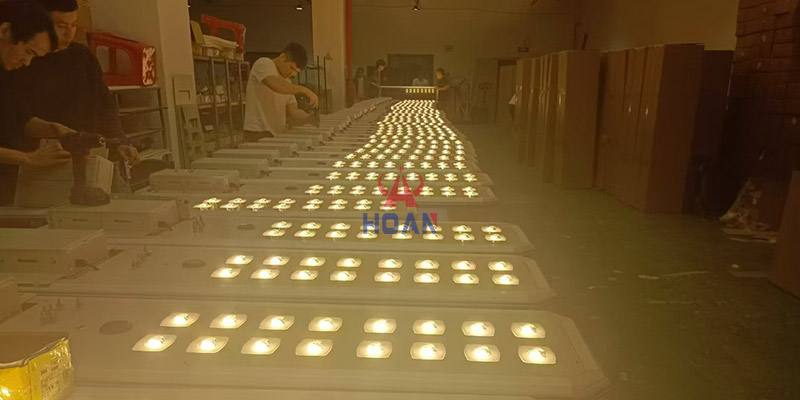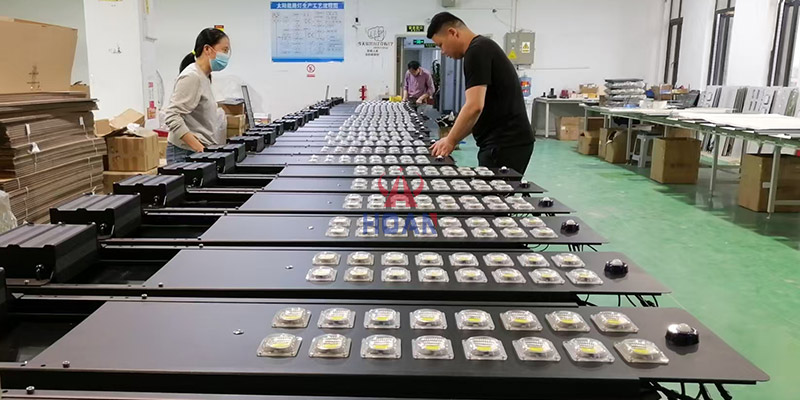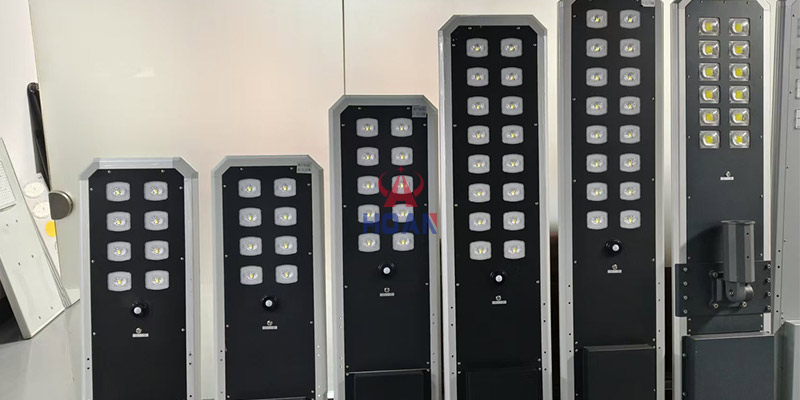Under the general trend of global energy transformation and the wave of smart city construction, solar street lights are receiving more and more attention as an important solution for green lighting. With the enhancement of people's environmental awareness and the pursuit of sustainable development, the market demand for solar street lights continues to heat up. Whether it is a busy city street, a quiet countryside path, or a scenic tourist attraction, solar street lights can be seen, and their strategic significance is becoming more and more prominent.
Photoelectric effect principle
The energy conversion of solar led street light is based on the magical photoelectric effect. Its core component, the solar panel, is usually made of silicon-based semiconductor materials. When sunlight hits the solar panel, photons interact with atoms in the semiconductor material. The energy of the photons is absorbed by the atoms, allowing the electrons in the atoms to gain enough energy to break free from the nucleus, thus creating electron-null pairs. Under the action of the electric field inside the semiconductor, the electrons and holes move in different directions, forming an electric current that successfully converts solar energy into electricity.
Energy Storage System
The converted electrical energy needs to be stored for use at night or when there is insufficient light. Currently, the commonly used energy storage devices for solar street lights include lithium batteries and lead-acid batteries. Lithium batteries have the advantages of high energy density, long life and low self-discharge rate, and their charging and discharging process is based on the embedding and detaching of lithium ions between the positive and negative electrodes. Lead-acid batteries, on the other hand, have lower cost and mature technology, and achieve electrical energy storage through the chemical reaction between the positive and negative active substances and the electrolyte. The size of the battery capacity directly affects the duration of the street light, and a reasonable battery configuration is the key to guarantee the continuous lighting of the street light.
Environmentally Friendly Attributes
As a clean energy source, solar energy achieves zero carbon emission during the use of solar street lights. Unlike traditional streetlights that rely on utility power (mainly provided by thermal power generation), solar streetlights do not consume fossil energy and do not produce greenhouse gases such as carbon dioxide and sulphur dioxide. Taking a 30W solar street light as an example, assuming it works for 10 hours a day, it can reduce carbon dioxide emissions by about 107.55kg a year, contributing to the fight against global climate change.
Energy self-sufficiency mode
The energy self-sufficiency mode of solar street light has obvious advantages in remote areas and areas without power grid coverage. It is costly and difficult to lay power grids in these areas, while solar streetlights do not need to rely on external power grids, and can work continuously as long as there is sunlight, which effectively solves the lighting problems caused by insufficient power infrastructure, and provides reliable lighting guarantee for local residents and traffic.

Automatic switching function
The solar street light is equipped with light-sensing elements like keen ‘eyes’ that can monitor the environmental brightness in real time. When night falls and the ambient light becomes dark to a certain degree, the light sensing element triggers the control system and the street light is automatically turned on; in the early morning, as the light becomes brighter, the street light will be automatically turned off again without manual intervention, realising intelligent lighting control.
Brightness Adjustment Technology
In addition to automatic switching, the solar street light also has a variety of brightness adjustment modes. The time-control mode can set the brightness of the streetlight according to the lighting demand at different times. For example, it automatically reduces the brightness to save electricity when the traffic and people flow is low late at night; the human body sensor mode detects whether there are people or vehicles around through sensors, and raises the brightness of the street light when someone is near, and restores the low brightness after the person leaves, which not only ensures the lighting demand, but also saves energy to the maximum extent.
Advantage of LED light source
LED light source is the ideal choice for solar street lights. Compared with traditional incandescent bulbs, high pressure sodium lamps and other light sources, LED light source has significant advantages. Its luminous efficiency is as high as 100 - 150lm/W, while the traditional incandescent bulb is only 10 - 20lm/W. The colour rendering index (CRI) can reach more than 80, which can more realistically restore the object's colour, while the traditional light source is relatively poor; the life span of the LED light source is as long as 50,000 - 100,000 hours, which greatly reduces the frequency of replacement and maintenance costs.
Optical design optimisation
In order to achieve uniform and dead-angle-free lighting effect, the solar street light has been carefully optimised in terms of optical design. Through the specially designed lens and lampshade, the light emitted from the LED is refracted and diffused, so that the light can evenly illuminate the road, avoiding uneven brightness and darkness, and providing a comfortable and safe lighting environment for pedestrians and vehicles.
Simplified installation process
Solar street light installation is relatively simple, without complex wiring works. Traditional street light installation requires laying cables, building transformers, etc., which makes construction difficult and costly. On the other hand, solar street lights only need to fix the pole and connect the solar panels, batteries, LED lights and other components, which greatly reduces the construction cost and time cost. In some areas with complicated terrain, the advantages of this simplified installation are even more obvious.
Policy subsidy support
In order to promote the application of clean energy, governments around the world have introduced the acquisition of solar street lights subsidies, tax incentives and other policies. For example, certain regions give a certain percentage of capital subsidies to solar street light projects or reduce or waive relevant taxes, which further reduces the initial investment cost of solar street lights and improves their market competitiveness.
Zero Electricity Expenditure
Solar streetlights are powered by solar energy, so there is no need to pay for electricity in the long run. Taking a lighting project with 100 streetlights as an example, assuming that each streetlight has a power of 30W and works for 10 hours a day, with an electricity unit price of 1 yuan/unit, the annual electricity expenditure of traditional streetlights is as high as 10950 yuan, while solar streetlights completely eliminate this cost. With the passage of time, the electricity cost saved will be a considerable figure.
Low Maintenance Costs
The long life of the LED light source reduces the hassle and cost of frequent bulb replacements. The intelligent fault warning system of solar street light can monitor the working status of the street light in real time, and once a fault occurs, it will issue an alarm in time, which is convenient for the maintenance personnel to locate and solve the problem quickly, and greatly reduces the cost of manual inspection and maintenance. Compared with traditional streetlights, the maintenance cost of solar streetlights can be reduced by more than 60%.

Excellent Environmental Adaptation Characteristics
High temperature environment performance
In a high temperature environment, the heat dissipation design of the solar street light is crucial. By adopting highly efficient heat sinks, heat dissipation holes and other structures, as well as high-temperature-resistant materials, it ensures that the internal components of the street light can work normally in high-temperature environments above 45℃, and will not be affected or damaged due to overheating.
Low temperature environment protection
In cold winter, especially in areas where the temperature is as low as -30°C, the insulation technology and frost-resistant materials of lithium batteries play a key role. By equipping the battery with an insulation layer and adopting electrolyte with good low-temperature performance and other measures, it ensures that the battery can still be charged and discharged normally at low temperatures, so that the street light can operate stably even in severe cold weather.
Wind and earthquake resistant design
The pole of solar street light is specially designed to have excellent wind and seismic resistance. Generally speaking, its wind pressure level can reach 12 typhoon standards. Through reasonable pole structure design, reinforcement setting and solid foundation fixing scheme, it ensures that the street light can still stand in the face of strong winds, earthquakes and other natural disasters.
Waterproof and dustproof performance
Solar street light has high waterproof and dustproof rating, commonly IP65/IP67, which means that the street light can effectively prevent dust from entering into the interior, and at the same time in the case of heavy rain, flooding, etc., will not be damaged due to water ingress, which ensures that the street light in a variety of harsh environments, the reliability and stability of the street light.

Application of Internet of Things (IoT) technology
With the help of NB-IoT, LoRa and other IoT technologies, the solar street light realises remote monitoring and intelligent management. Managers can remotely control the switch of the street light, adjust the brightness and check the working status of the street light in real time through mobile phone APP or computer platform. Once the street light fails, the system will immediately send out an alarm message to facilitate the maintenance personnel to deal with it in time, which greatly improves the management efficiency.
Data Management Platform
The data management platform of solar street light can collect and analyse the energy consumption data, working hours, fault records and other information of the street light in real time. Through the analysis of these data, managers can optimize the operation strategy of the street light, such as adjusting the brightness adjustment mode, reasonably arranging the maintenance plan, etc., to achieve more refined management.
Urban road application
In urban road lighting, solar street lights can be linked with traffic signals. For example, when the traffic signal light becomes red, the nearby street lights automatically increase the brightness to enhance the lighting effect of the intersection and protect the safety of pedestrians and vehicles; when the green light is on, the normal brightness is restored to realise intelligent dimming and enhance the intelligent level of urban traffic.
Rural Lighting Programme
For rural areas, solar street light can adopt low illumination and long duration mode. In the case of less traffic and people flow at night in the countryside, reduce the brightness of the street light and extend the lighting time to meet the basic lighting needs of rural residents, while maximising energy saving and adapting to the actual use of the rural areas of the scene.
With the core features of clean energy drive, intelligent and efficient lighting, full life cycle cost advantage, excellent environmental adaptability and intelligent interconnection innovation, solar street light shows strong competitiveness in the lighting field. Its zero carbon emission and energy self-sufficiency are in line with the concept of sustainable development; intelligent light control and high-quality lighting effect enhance the lighting quality; low investment and low maintenance cost bring good economic benefits; reliable structure and intelligent management make it suitable for various complex scenes.